| | Proper design and siting of a private sewage treatment system | Types of on-site private sewage systems | Wastewaters and associated concerns | Maintaining on-farm sewage systems | Legislation | For more information
Almost all farm homes use private sewage treatment systems, which collect, treat and dispose of treated wastewater from a single source in the same location that it is generated. The most common type of on-site sewage system is a septic system, which includes a holding tank where bacteria decompose waste products into effluent, indigestible solids and gases. The effluent is discharged on-site, while the undigested solids remain in the tank to be pumped out on a regular basis.
These systems are usually economical and reliable, but they must be properly maintained to handle all the wastewater produced. The system must also treat the wastewater to prevent further surface water and groundwater contamination since it may contain bacteria, infectious viruses, household chemicals and excess nutrients such as nitrates and phosphates. Learning more about your present system can help determine if it is treating your household wastewater properly.
Proper Design and Siting of a Private Sewage Treatment System
To prevent potential contamination on your farmstead, you should ensure that your sewage system is designed and functioning properly so that wastewater is treated effectively. To achieve this goal, there needs to be sufficient wastewater amounts, good wastewater movement and a proper system design. These components also ensure complete distribution and reduce the incidence of freezing within the system. Steps should be taken to prevent oversaturation of disposal field systems.
It is important to look at the farmstead site to determine where potential problems could arise. Unfavourable soil characteristics, high water tables and impervious layers could very well impede a household wastewater system. You need to consider the location of the system as well as the potential wastewater volumes and the strength of sewage being generated to minimize any potential environmental risks.
When siting the sewage system on the farmstead, consider the following options:
- direct run-on waters away from the disposal area
- discharge sewage effluent away from a water body or vegetable garden
- ensure distances from buildings, dwellings, property lines, water sources and water bodies follow what is outlined in the Private Sewage Disposal Systems Regulation for Alberta
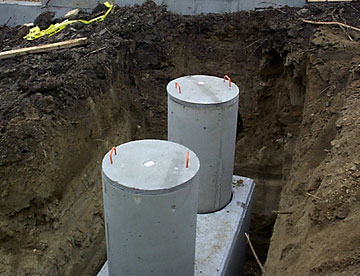
Septic tank installation
Courtesy of Safety Services, Alberta Municipal Affairs
Types of On-site Private Sewage Systems
The first step to ensuring that your sewage system is working properly is to know what type of system you have.
On-site private sewage systems can include one or a combination of the following:
Holding tank - A holding tank is an approved watertight receptacle for the collection and temporary storage of sewage, until it can be pumped out. Mobile equipment is used to empty the tank, and the sewage is disposed of in an acceptable manner.
Septic tank - The septic tank is a digestion chamber comprised of two steps in which sewage is retained and effluent is discharged (see Figure 9.1). The first chamber settles out the solids producing a sludge layer, which is pumped out after a certain time period. The second chamber receives the effluent from the first chamber, which is then stored and intermittently discharged to an effluent treatment and disposal system.
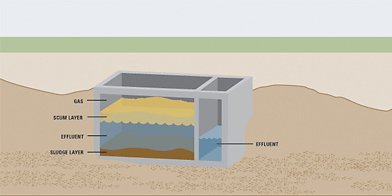
Figure 9.1. Septic tank system
Packaged sewage treatment plant - A packaged sewage treatment plant is a high tech septic tank that produces a higher quality effluent than a standard septic tank. Air is stirred or bubbled into the waste to help breakdown the material, resulting in sludge and a reasonably clear effluent. The effluent is discharged to the final treatment component of the disposal system, and the sludge is periodically pumped out.
Sand Filters - Sand filters receive effluent from a septic tank and provide further treatment. This additional treatment is achieved using a pressurized distribution system within the sand filter, which intermittently discharges effluent evenly over the surface of the sand. The sand provides an aerobic environment and contains bacteria that treat the effluent. Once treated, the effluent is then collected and pumped to a final disposal system.
Disposal field - A disposal field system is an effective means of distributing effluent evenly within a soil-covered trench containing void spaces. Microorganisms living in the soil then use oxygen in these voids to breakdown the effluent into safer components.
Types of disposal fields include:
- conventional system that uses perforated piping laid in gravel-bedded trenches and usually sub-surface weeping tiles to help distribute effluent in the soil (see Figure 9.2)
- chamber system that uses perforated structures to provide void spaces for storage and movement of effluent and an interface with the exposed soil surface for infiltration
- gravel substitute that is a conventional disposal field in which gravel is replaced with an alternate media having characteristics that provide void spaces and performance similar to gravel
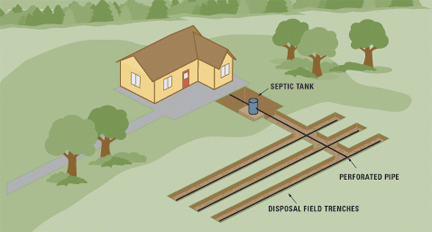
Figure 9.2. Conventional disposal field system
Treatment mounds - Treatment mounds are built above grade to overcome limits imposed by proximity to water tables, bedrock or by highly permeable or impermeable soils (see Figure 9.3). Effluent pumped to the mound then drains through a layer of sand, in which aerobic bacteria exist to treat the effluent.
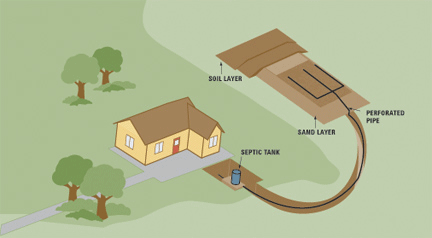
Figure 9.3. Treatment mound system
Open discharge systems - An open discharge system discharges effluent on to the ground surface, so the effluent evaporates and absorbs into the soil as a method of treatment (see Figure 9.4). The system must contain the effluent on the property and protect the soil at the outlet from erosion. Alternative designs for open discharge systems exist depending on the slope of the land and size of system components.
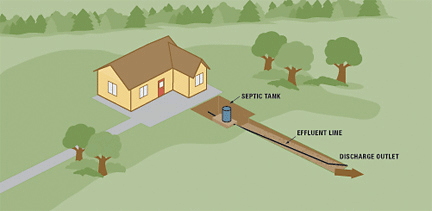
Figure 9.4. Open discharge system
Sewage lagoon - Sewage lagoons are shallow, artificial ponds that are lined prevent the downward movement of effluent into the soil and groundwater (see Figure 9.5). This sewage system stabilizes effluent overtime by providing an environment that allows for evaporation and breakdown of sewage components by bacteria and algae.
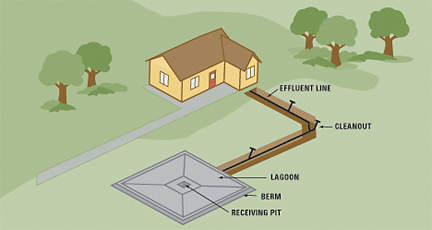
Figure 9.5. Sewage lagoon
Cesspools - Cesspools are covered, underground containers or pits for the temporary storage of liquid waste and sewage. They exist on older farm sites, but are not considered acceptable by today’s standards. The liquid portion of the sewage is disposed of by seeping or leaching through a perforated liner into the surrounding soil, while the sludge is retained to undergo partial decomposition before occasional removal.
Over time, a bio-mat accumulates on the walls, plugging off its leaching surface making it inoperable. This result could cause a cesspool to overflow, allowing untreated effluent to pose environmental and health safety risks. Where cesspools were excavated to depths that entered water tables, the high water tables would infiltrate into the cesspool, causing them to overflow as well as wash the bio-mat away from its wall surfaces. Then as the water table receded, the poorly treated effluent would migrate into the water table and cause potential contamination to other water sources such as water wells.
The construction of cesspools is no longer permitted.
Gravity distribution versus pressure distribution of effluent
A gravity distribution system may overload and provide soil microbes with more food than they can consume. The soil may also become saturated under a gravity distribution system and is not favourable for aerobic microbes to treat the sewage. Pressure distribution provides a more even dispersion of effluent in a disposal field or mound, resulting in a more effective wastewater treatment and extending the life of the system.
Wastewaters and Associated Concerns
Certain wastewaters on a farmstead need to be handled properly. Backwash from iron filters and water softeners, garborator wastes from the kitchen, grease and oils all need special attention.
Backwash water from iron filters - Wastewater from iron filters should not be discharged into the septic system. Iron filters typically discharge a significant volume of water that needs to be accounted for in design, otherwise it may overload the system. Also, the iron removed from the water supply and then discharged with the backwash water can have a negative effect on the capability of the soil to absorb water.
Backwash water from a water softener - Using sodium salts in a water softener may be harmful to a sewage disposal system. Increased sodium levels may reduce the effectiveness of the septic tank by negatively affecting microbial activity. As well, high sodium in the effluent may reduce the ability of the soil to absorb and move the effluent, especially in the presence of clay.
As the wastewater from these systems is not considered contaminated, it can be discharged on top of the ground in a location on the property that the owner considers suitable.
Garborator Wastes - A garbage grinder (commonly known as a garborator) will increase the amount of organic matter in a septic system. This increase in organic matter results in a higher Biological Oxygen Demand (B.O.D.) on the soil treatment system, increasing the risk of system failure. With septic tanks, the grinder adds additional solids that will decrease the capacity of the tank. When garbage grinders are used, it is recommended that the septic tank size and final treatment system be increased.
Grease and oils - Grease and oils are complex molecules that are difficult to breakdown and should not be discharged into a private sewage system because they can cause the system to plug up. To avoid this problem, minimize the use and disposal of grease and oils into the system. Consider scraping off greasy food and wiping dishes with disposable paper towels. If using large quantities, use grease traps and contact an experienced waste disposal and handling company for options.
Maintaining On-Farm Sewage Systems
Operating a private sewage system on a farmstead requires knowledge and skill. A good sewage system prevents damage to the environment, and it also helps to protect the health of your family and neighbours. Newer technology is allowing for rural sewage systems to provide treatment beyond the capability of older systems, allowing for longer life of the system and reducing any environmental and health safety risks.
The key to operating a good private sewage system depends on which system you choose for the farmstead. Some of the more traditional systems use a septic tank with a disposal field. With this type of system, it is essential that it be maintained.
Septic Tank Maintenance
Solids in the septic chamber of a septic tank are broken down at a slower rate in the anaerobic environment of the tank. These solids, along with greases, soap curds and other material that float on the liquid surface (scum layer), accumulate overtime and reduce the storage capacity of the septic chamber (refer back to Figure 9.1). Solids must then be periodically removed from the chamber and disposed of in another manner to ensure the tank functions properly.
Timely cleaning of a septic tank is important. Solids and other organic material can be carried from the septic chamber into the effluent chamber and discharged into the effluent disposal system. This situation can eventually result in system failure, as additional suspended solids and organic material will plug the system and reduce the infiltration capacity of the soil surface.
The size of the septic chamber determines the intervals between cleaning. The larger the septic chamber, the better the separation of solids from the effluent, especially during peak flows. The septic chamber should be checked each spring or early summer for accumulated sludge and scum. A septic chamber with 45 cm (18 in) of sludge should be cleaned.
Emptying the tank in the spring will allow bacterial action to resume more quickly during the warmer summer months. It is not necessary to thoroughly scrub and flush the septic chamber until it is visibly clean. The small amount of sludge that remains on the floor and walls will serve as microbial inoculants, which will allow normal operation to resume as soon as possible. Vacuum-pumped sewage hauling trucks are available commercially to empty septic tanks. This equipment is capable of doing an excellent job without spillage.
Current disposal options for solid wastewater material or septic tank contents consist of two kinds: land application and wastewater treatment plants. Where hauling distances make the delivery of the wastewater to a treatment plant not feasible, land application is the most economic and viable option. Disposal of private wastewater on agricultural land is an acceptable practice. However, disposing of municipal wastewater is regulated and must follow certain restrictions governed by Alberta Environment. Always keep records indicating where, when and how much wastewater was applied.
Land applications with such wastewater should occur:
- between April and October of each year
- on soil with a pH > 6.5
- on slopes < 5 percent
- on land with depth to water table > 2 m (7 ft)
- when wastewater can be injected or incorporated within 48 hours
Land applications should not occur:
- when application rates exceed 100 m3/ha
- near water sources and water bodies, dwellings, roads, public buildings, school yards, cemeteries, playgrounds, parks and campgrounds
- on ice, snow-covered or frozen ground
- near or in stream valleys or intermittent drainage areas
- on land being used for root, vegetable or fruit crops or dairy farming pasture
For more information on wastewater land application guidelines, contact Alberta Environment.
Greywater Options
Greywater is wastewater from bathing, washing and laundry, but does not contain toilet wastes, food wastes, dirt or other contaminants (known as blackwater). It can be treated in a private septic system, but is not as high in nutrients or pathogens as typical household wastewater. Bacteria in a septic field do need nutrients to survive, so greywater itself may not provide enough nourishment for them to keep the septic field healthy and active.
There are other disposal options for greywater when it is separated from blackwater due to the low presence of pathogens. Thus, greywater can be used for irrigating, but only on non-food plants since there is a chance of contaminating plants used for food. It can also be discharged below ground in a drip irrigation system where soil bacteria will filter any pathogens and nutrients out of the water. Regardless of the disposal method, separation distances for greywater from property edges, wells, water sources, watercourses and buildings must be met and all runoff should be contained on the property.
Emergency Plan
Every farmstead needs an emergency plan, which outlines the location of hazardous materials, emergency equipment, telephone numbers and necessary clean-up instructions. The plan gives those living on the farmstead guidelines to follow for minimizing potential environmental damage to the site, as well as protects those living on the site and in the surrounding community. For more information about emergency planning and the steps necessary to minimize environmental risk and ensure the safety of others, refer to the Appendix.
Legislation
Producers should be aware of the following pieces of legislation that pertain to household wastewater management. For more information on the legislation, refer to Chapter 12 of this manual.
Provincial Legislation
Safety Codes Act
Private Sewage Disposal Systems Regulation
For More Information
All Alberta government offices may be reached toll-free by dialing the Rite Line: 310-0000
Alberta Environment
Publications: 780-427-2700
- Guidelines for the Application of Municipal Wastewater Sludges to Agricultural Lands March 2001
Information Centre: 780-427-2700
Website: environment.alberta.ca/
Alberta Municipal Affairs
Safety Services: 1-866-421-6929
- Alberta Private Sewage Systems Standard of Practice 1999 Handbook
Website: www.municipalaffairs.gov.ab.ca
Alberta Onsite Wastewater Management Association
Publications: 780-489-7471
- Private Onsite Waterwater Treatment System Owners
Website: www.aowma.com |
|